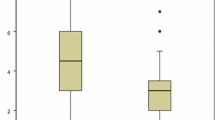Abstract
Objective: To study the comparative efficacy of the quinine and artesunate in complicated malaria in children.Methods: All cases admitted to the Pediatrics ward of our hospital with clinical features of complicated malaria (WHO criteria) having asexual forms of P.falciparum in the peripheral smear, were included in the study. Relevant investigations were carried out for confirmation of diagnosis and to assess the prognosis. The patients were sub-grouped into 6 categories as per clinical presentations and each subgroup received alternatively either quinine or artesunate by systematic random sample method. Every odd number received quinine (Group-1) and every even number received artesunate (Group-2). 40 cases in each group were considered for the study and the data obtained were compiled and analyzed by suitable statistical tests.Results: 80 children with complicated malaria enrolled in the present study, of which 48 were boys and 32 were girls. The mean age was 7.93+3.56 years. The most common presentations were fever, splenomegaly and altered sensorium. The CRT, FCT and PCT were significantly less in the artesunate group (50.4 ±31.49hrs; 43.55 ±20.12 hrs, and 41.67 ±16.78 hrs respectively) as compared to the quinine group (70.15 ±17.56 hrs, 62.23 ±16.99 hrs, and 52.24 ±12.69 hrs respectively) (p<0.05) No side effects were observed in the artesunate treated group.Conclusion: Artesunate is a much better drug than quinine in complicated malaria in terms of rapid coma resolution,fever clearance,parasite clearance and better tolerability
Similar content being viewed by others
References
Malaria. World Health Fact sheet No. 95. Genava. World Health Organisation, Revised October 1998.
Mutanda LN. Assessment of drug resistance to malaria parasite in residents of Kampala, Uganda.East Afr Med J 1999; 76:421–424.
Brasseur P, Kouamouo O, Moyou SR, Druillie P. 1998. Patterns ofin vitro resistance to chloroquine, quinine and Mefloquine ofplasmodium falciparum in Camerron in 1985–1986.Am J Trop Hyg39:166–172.
Looatsuvan S, Chatoenpam I, Ho MJ, White NJ, Karbang J, Bunang D, Harinasuta T. FatalPlasmodium falciparum malaria after an inadequate responcse to quinine treatment.J Inf Dis 1990; 161:577–580.
Hong, G. (AD 340).Handbook of Emergency Treatment.
Qinghaosu Antimalarial Coordinating Group. Antimalarial studies on qinghaosu.Chinese Medical Journal 1979; 98:811–816.
Li GQ, Guo XB, Fu LC, Jian HX, Wang XH. Clinical trials of artemisinin and its derivatives in the treatment of malaria in China.Trans R Soc Trop Med Hyg 1994; 88 Suppl 1: S5–6.
Taylor TE, Wills BA, Kazembe P, Courval JM, and MolyneuxME. Intramuscular artemether vs intravenous quinine:an open,randomized trial in Malawian children with cerebral malaria.Tropical Medicine and International Health 1998; 3: 3–8.
Murphy S, English M, Waruiru C, Mwangi I, Amukoye E, Crawley Jet al. An open randomized trial of artemether versus quinine in the treatment of cerebral malaria in African children.Transaction of the Royal Society of Tropical Medicine and Hygiene 1996; 90: 331–334.
World Health Organisation.Division of control of Tropical Diseases. Severe and complicated malaria.Trans R Soc Trop Med Hyg 1990; 84 (Supplement 2): 1–65.
Roger SM, Felix T, Martin O, Lysette EK, Tetanye E, Elie Met al. Clinical trial of B-arteether versus quinine for the treatment of cerebral malaria in children in Yaounde, Cameroon.Am J Trop Med and Hyg 2001; 64(5,6): 229–232.
Jain J. Cerebral and other types of severe malaria. In: Singh M editor. Medical Emergencies in Children, 3rd ed. New Delhi, Sagar Publication; 2000; 219–228.
Salako LA, Walker O, Sowunmi A, Omoklodion SJ, Adio R, Oduola AM, Artemether in moderately severe and cerebral malaria in Nigerian children.Trans R Soc Trop Med Hyg 1994; 88 (suppl.l): 13–15.
Mishra SK, Asthana OP, Mohanti S, Pattnaik JK, Das RS, Srivastav JSet al. Effectiveness of a, B-arteether in acute falciparum malaria.Trans R Soc Med Hyg 1995; 89: 299–301.
Myent P and Shwe T. A controlled trial of arteether (qinghaosu derivative) versus quinine in complicated severe falciparum malaria.Trans R Soc Trop Med Hyg 1987; 81: 559–561.
Hien TT, Day NPJ, Phu NH, Mai NTH, Chou TTH, Loe PPet al. A controlled trial of artemether or quinine in Vietnamese adults severe falciparum malaria.New England Journal of Medicine 1996; 335: 76–83.
Stepalewaka K, Day N, Babiker A, Luloo D, Warrel D, OlliaroP. Working committee on a meta analysis using individual patient data of trials comparing artemether with quinine in the treatment of severe falciparum malaria.Trans R Soc Trop Med and Hyg 2001; 95: 637–650.
Price RN, Van vugt M, Phaipun L, Luxemberger C, Simpson J, McGready Ret al. Adverse effects in patients with acute falciparum malaria treated with Artemisinine derivative.Am J Trop Med Hyg 1999; 60: 547–555.
Author information
Authors and Affiliations
Corresponding author
Rights and permissions
About this article
Cite this article
Mohanty, A.K., Rath, B.K., Mohanty, R. et al. Randomized control trial of quinine and artesunate in complicated malaria. Indian J Pediatr 71, 291–295 (2004). https://doi.org/10.1007/BF02724090
Issue Date:
DOI: https://doi.org/10.1007/BF02724090




